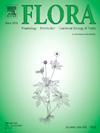The secrets of variegated leaves: Molecular to physiological and ecological insights
IF 1.8
4区 生物学
Q3 ECOLOGY
引用次数: 0
Abstract
Leaf variegation, characterized by multicolored patterns such as white, yellow, red, or purple hues, deviates from the uniform green coloration typical of most plants due to complex genetic, physiological, and structural mechanisms. It can arise from stable genetic mutations or transient environmental influences and is broadly classified into structural and pigment-based types. Mechanistically, variegation is further divided into four categories based on chlorophyll absence, internal air spaces, epidermal structure, or localized pigment expression. Genetic studies in model species such as Arabidopsis thaliana, tobacco, rice, and tomato have revealed that mutations affecting chloroplast biogenesis and pigment biosynthesis often underlie variegated phenotypes. In addition to its ornamental appeal, variegation plays critical physiological and ecological roles, influencing photosynthesis, photoprotection, thermoregulation, and plant-herbivore interactions. Pseudo-variegation, a visually similar but a non-genetic phenomenon induced by other organisms, can also confer adaptive advantages such as herbivore deterrence and environmental stress tolerance. Recent research highlights the importance of integrating molecular, anatomical, and ecological perspectives to fully understand the developmental and adaptive significance of leaf variegation in higher plants.
杂色叶子的秘密:从分子到生理和生态的见解
由于复杂的遗传、生理和结构机制,叶子杂色以白色、黄色、红色或紫色等多色图案为特征,偏离了大多数植物典型的统一绿色。它可以由稳定的基因突变或短暂的环境影响引起,大致分为结构型和色素型。从机理上讲,斑纹根据叶绿素缺失、内部空气空间、表皮结构或局部色素表达进一步分为四类。对拟南芥、烟草、水稻和番茄等模式物种的遗传研究表明,影响叶绿体生物发生和色素生物合成的突变往往是表型多样化的基础。除了具有观赏价值外,杂色还具有重要的生理和生态作用,影响光合作用、光保护、温度调节和植物与食草动物的相互作用。伪杂色,一种视觉上相似但由其他生物引起的非遗传现象,也可以赋予适应性优势,如食草动物威慑和环境应激耐受性。近年来的研究强调了整合分子、解剖学和生态学的观点对充分理解高等植物叶片变异的发育和适应意义的重要性。
本文章由计算机程序翻译,如有差异,请以英文原文为准。
求助全文
约1分钟内获得全文
求助全文
来源期刊

Flora
生物-植物科学
CiteScore
3.30
自引率
10.50%
发文量
130
审稿时长
54 days
期刊介绍:
FLORA publishes original contributions and review articles on plant structure (morphology and anatomy), plant distribution (incl. phylogeography) and plant functional ecology (ecophysiology, population ecology and population genetics, organismic interactions, community ecology, ecosystem ecology). Manuscripts (both original and review articles) on a single topic can be compiled in Special Issues, for which suggestions are welcome.
FLORA, the scientific botanical journal with the longest uninterrupted publication sequence (since 1818), considers manuscripts in the above areas which appeal a broad scientific and international readership. Manuscripts focused on floristics and vegetation science will only be considered if they exceed the pure descriptive approach and have relevance for interpreting plant morphology, distribution or ecology. Manuscripts whose content is restricted to purely systematic and nomenclature matters, to geobotanical aspects of only local interest, to pure applications in agri-, horti- or silviculture and pharmacology, and experimental studies dealing exclusively with investigations at the cellular and subcellular level will not be accepted. Manuscripts dealing with comparative and evolutionary aspects of morphology, anatomy and development are welcome.
 求助内容:
求助内容: 应助结果提醒方式:
应助结果提醒方式:


